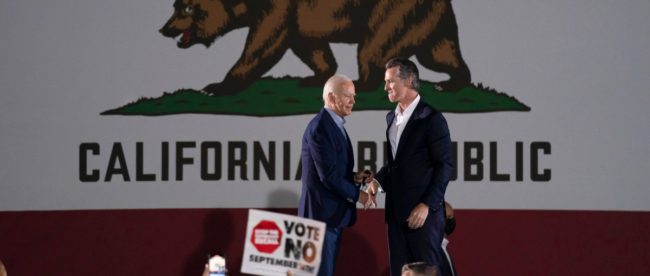An Analysis of the 2021 California Recall Election
By Parsa Basseri and Siddharth Chavan
9/30/2021
A recall is a process in which the citizens of a state or city can replace previously elected officials before their term ends. Often considered a controversial facet of American state government, recalls are a form of direct democracy in which the voters themselves decide on whether or not to remove a state official.
The essential steps to initiate a recall effort in California are simple. Any registered voter can begin this process, and the reason for the recall can be anything unless otherwise specified by law. Organizers of the recall must gather signatures within a certain number of days, with the number of signatures required being equal to a percentage of the votes in the previous general election. If enough signatures are gathered, a special election is held in which voters can decide on whether to recall the official and choose which candidate should replace them (Underhill, 2021).
California has had a long history of recall elections. In total, 179 recall attempts have been against California government officials, including 55 governors, 30 state senators, and even an entire Supreme Court—though only 11 petitions have ever obtained enough signatures to prompt an election. The only successful gubernatorial recall in California history occurred in 2003 when former governor Gray Davis was replaced by movie star Arnold Schwarzenegger (California Secretary of State, 2021).
Californians then were critical of how Governor Davis handled the power crisis. With his approval ratings at 26 percent, there were justifiable reasons for the recall effort to succeed. But Gavin Newsom won the 2019 governor race in a landslide and his approval ratings sit at a respectable 53 percent (Matsumoto, 2021). So how did the 2021 recall effort get nearly as far as it did?
Newsom’s stances have long been frustrating for many Californians. An uncompromising progressive, he has consistently displeased conservatives with his stances on key issues such as same-sex marriage, gun control, and recreational drugs. Critics of Newsom also claim that he has repeatedly overstepped the bounds of his office, bypassing state law as both the Mayor of San Francisco and the Governor of California (Hubler, 2021a).
The most significant motive for the recall, however, was undoubtedly Newsom’s handling of the COVID-19 pandemic. Part of Newsom’s response to the pandemic was to put in place heavy restrictions on public gatherings. Schools, businesses, and places of worship were shut down, mask requirements were enforced, and vaccine mandates came into effect; recall supporters believe that many of these restrictions disproportionately impacted poorer communities and small business owners (Woo, Cowan, Medina, and Jordan, 2021).
To add salt to the wounds, in November 2020, Newsom was caught dining with friends and lobbyists at the French Laundry, an expensive Napa restaurant, against his own COVID protocols (Phillips, 2021). For many struggling Californians, this incident in particular painted Newsom as an out-of-touch elitist; and as election day inched closer, polls showed that the recall race would be tight. Results seemed evenly split between “yes” and “no”—a surprising statistic in a state where Democrats outnumber Republicans nearly two to one.
So how did Newsom beat the recall? The answer has very much to do with his opponent. Larry Elder, a well-known conservative talk show host from Los Angeles, entered the race on July 12 and immediately became the front-running Republican. He ran on a platform almost comedic in its contrarianism—for instance, he opposed the minimum wage, rejected climate change, denounced mask and vaccine mandates, and openly admitted that racial inequality was not a major issue in modern America (Steinhauser, 2021). Elder even drew ire from members of his own party following allegations of violence and the resurfacing of certain offensive comments (Hubler, 2021b).
Larry Elder was the last remaining piece of the puzzle, the crucial foil that Gavin Newsom needed in order to energize his voter base. Rather than wasting time trying to appeal to undecided voters, Newsom focused on bringing out his own voter base, portraying Elder as an agent of Trumpism and a threat to California’s safety (Hubler, 2021b). One campaign ad even proclaimed that the stakes of the September 14 recall were “a matter of life and death,” stating that Elder’s positions on masks and vaccines could cost thousands of Californians’ lives (Forbes, 2021).
When September 14 finally arrived, the results were nowhere close to what the polls had predicted. Sixty-two percent to thirty-eight percent—a resounding victory for Newsom and, many would argue, for California.
—
References
California Secretary of State. (n.d.). Recall history in California (1913 to present). California Secretary of State. Retrieved September 30, 2021, from https://www.sos.ca.gov/elections/recalls/recall-history-california-1913-present.
Hubler, S. (2021, June 3). The California Recall, untangled. The New York Times. https://www.nytimes.com/article/california-recall-election-gavin-newsom.html.
Hubler, S. (2021, August 24). How did Larry Elder become a front-runner in California’s governor race? The New York Times. https://www.nytimes.com/2021/08/24/us/larry-elder-california-governor-recall.html.
Matsumoto, R. (2021, September 13). Higher approval, a new electorate and no arnold. this isn’t 2003. The New York Times. https://www.nytimes.com/2021/09/13/upshot/california-recall-election-newsom.html.
Phillips, A. (2021, September 14). What to know about California Gov. Newsom’s recall. The Washington Post. https://www.washingtonpost.com/politics/2021/08/25/california-governor-recall-election-gavin-newsom/.
Steinhauser, P. (2021, September 14). California recall election: Everything you need to know. Fox News. https://www.foxnews.com/politics/california-recall-election-everything-you-need-to-know.
Underhill, W. (2021, September 15). Recall of state officials. National Conference of State Legislatures. Retrieved September 30, 2021, from https://www.ncsl.org/research/elections-and-campaigns/recall-of-state-officials.aspx.
Woo, E., Cowan, J., Medina, J., & Jordan, M. (2021, September 15). The pandemic was the No. 1 issue for many voters in California’s recall election. The New York Times. https://www.nytimes.com/2021/09/15/us/pandemic-california-recall-voters.html.


Awesome writing guys! It’s not an easy topic but you made it really interesting and straightforward.
Well researched and supported.